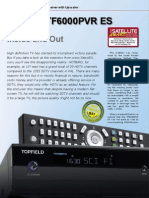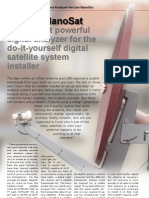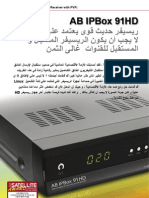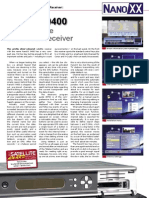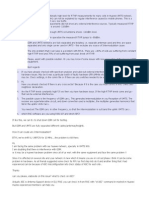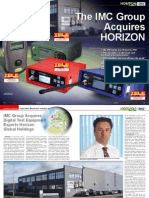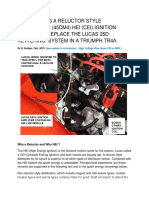Jiuzhou Skytrack JSU33: LNBF For Multifeed Systems
Jiuzhou Skytrack JSU33: LNBF For Multifeed Systems
Uploaded by
Alexander WieseCopyright:
Available Formats
Jiuzhou Skytrack JSU33: LNBF For Multifeed Systems
Jiuzhou Skytrack JSU33: LNBF For Multifeed Systems
Uploaded by
Alexander WieseOriginal Description:
Original Title
Copyright
Available Formats
Share this document
Did you find this document useful?
Is this content inappropriate?
Copyright:
Available Formats
Jiuzhou Skytrack JSU33: LNBF For Multifeed Systems
Jiuzhou Skytrack JSU33: LNBF For Multifeed Systems
Uploaded by
Alexander WieseCopyright:
Available Formats
TEST REPORT Ku-Band LNB
Jiuzhou
Skytrack JSU33
LNBF for multifeed
systems
If you ask a satellite fan what is most important
when choosing the right LNBF for the Ku-Band
reception system, you will most probably hear that
this is the conversion gain and the noise figure. The
first should be as high as possible and the second on
the contrary: the lower the better. Most likely, all our
readers know that high conversion gain means that
the LNBF output signal level is high and thanks to
that long coaxial cables and signal splitters/switches
may be used without a fear that the signal will get
too weak for reception.
06-07/2009
JIUZHOU SKYTRACK JSU33
Lightweight LNBF very suitable for
multifeed installations.
TELE-satellite Test Editor Jacek Pawlowski ■
mounts the new Skytrack LNB from
Jiuzhou to a regular offset dish pointing
to HOTBIRD at 13°E. The JSU33 LNB is
surprisingly small and lightweight
54 TELE-satellite & Broadband — 06-07/2009 — www.TELE-satellite.com
www.TELE-satellite.com — 06-07/2009 — TELE-satellite & Broadband 55
TELE-satellite World www.TELE-satellite.com/...
Download this report in other languages from the Internet:
Arabic ﺍﻟﻌﺮﺑﻴﺔ www.TELE-satellite.com/TELE-satellite-0907/ara/jiuzhou.pdf
Indonesian Indonesia www.TELE-satellite.com/TELE-satellite-0907/bid/jiuzhou.pdf
Bulgarian Български www.TELE-satellite.com/TELE-satellite-0907/bul/jiuzhou.pdf
Czech Česky www.TELE-satellite.com/TELE-satellite-0907/ces/jiuzhou.pdf
German Deutsch www.TELE-satellite.com/TELE-satellite-0907/deu/jiuzhou.pdf
For the purpose of our test, English English www.TELE-satellite.com/TELE-satellite-0907/eng/jiuzhou.pdf
Spanish Español www.TELE-satellite.com/TELE-satellite-0907/esp/jiuzhou.pdf
we selected twelve transpond- Farsi ﻓﺎﺭﺳﻲ www.TELE-satellite.com/TELE-satellite-0907/far/jiuzhou.pdf
French Français www.TELE-satellite.com/TELE-satellite-0907/fra/jiuzhou.pdf
ers on HOTBIRD satellite (13° Greek Ελληνικά www.TELE-satellite.com/TELE-satellite-0907/hel/jiuzhou.pdf
East). Their parameters are Croatian Hrvatski www.TELE-satellite.com/TELE-satellite-0907/hrv/jiuzhou.pdf
Italian Italiano www.TELE-satellite.com/TELE-satellite-0907/ita/jiuzhou.pdf
listed in table 1. As you can Hungarian Magyar www.TELE-satellite.com/TELE-satellite-0907/mag/jiuzhou.pdf
Mandarin 中文 www.TELE-satellite.com/TELE-satellite-0907/man/jiuzhou.pdf
see, there are 3 transponders Dutch Nederlands www.TELE-satellite.com/TELE-satellite-0907/ned/jiuzhou.pdf
Polish Polski www.TELE-satellite.com/TELE-satellite-0907/pol/jiuzhou.pdf
for every sub-band (upper/ Portuguese Português www.TELE-satellite.com/TELE-satellite-0907/por/jiuzhou.pdf
Romanian Românesc www.TELE-satellite.com/TELE-satellite-0907/rom/jiuzhou.pdf
lower) and every polarization. Russian Русский www.TELE-satellite.com/TELE-satellite-0907/rus/jiuzhou.pdf
Swedish Svenska www.TELE-satellite.com/TELE-satellite-0907/sve/jiuzhou.pdf
In this way, we check the per- Turkish Türkçe www.TELE-satellite.com/TELE-satellite-0907/tur/jiuzhou.pdf
formance for both LOF’s: 9750 Available online starting from 29 May 2009
and 10600 MHz, both polariza-
tions: vertical and horizontal devices, for the four remain- ers, the output power was
and for the beginning, middle ing ones, it beat at least one bigger than the competitors.
Table 1. Transponders used and end of a sub-band. competitor and once even It is especially true for the
as test signals.
both (Tr-11). And yes, you are 0.3 dB which was the winner
The low noise figure should Figure 1 shows the noise per- right – the 0.2 dB device did in noise performance.
ensure good signal to noise formance of the devices. MER not seem to be better than
ratio at the output of LNBF, is a modulation error ratio – a 0.3 dB LNBF! That’s why we What conclusions you can
or more properly for digital
transmissions: carrier-to-
noise ratio. Low C/N is needed
to ensure the reception of
weaker transponders. It also
provides high margin for bad
weather conditions. Unfortu-
nately, the noise performance
of the real device is not that
easy to predict. Except for the
noise figure, there are other
parameters that influence the
carrier-to-noise ratio.
These parameters are:
Fig. 1. MER for twelve different transponders of HOTBIRD satellite (13° East).
the phase noise of the local
oscillator of an LNBF and its parameter strongly related to explained earlier that the draw out of those results?
spurious content, reverse C/N and telling us how many noise figure itself is not the Skytrack JSU33’s strong point
polarization isolation, level bit errors are detected in the only parameter one must is its high output power. So it
of intermodulation, image incoming signal. Do we need take into account and only can be a preferred choice for
rejection. So, the only practi- to add that those errors are the real life test can reveal multi-satellite reception when
cal way to asses the LNBF is caused by noise? The better everything! we use multiswitches and
to apply it on a real antenna noise performance of an LNBF, long cable to distribute the
and make it receive real the higher MER values. And what about the other signal to many receivers. The
world signals. The presence parameter? It is presented in other advantage of this LNBF
of neighboring transponders While for 8 lower frequency figure 2. And here the situ- for multifeed system is its
makes life harder for an LNBF transponders, the noise per- ation is the opposite: it is lower profile and weight (ca.
and degrades carrier-to-noise formance of the JSU33 was JSU33 that beat all the rest. 100 g) when compared with
performance. worse that the reference For 11 out of 12 transpond- other typical devices.
In a test like that, we com-
pare the actual perform-
ance of LNBF under test with
other LNBF’s available on the
market. That’s what we did
also when testing the LNBF
of Jiuzhou: Skytrack JSU33.
Its noise figure is specified
as 0.6 dB. We compared it
with 2 other contemporary
LNBF’s: one with NF specified
as 0.3 dB and the other with
NF=0.2 dB. Figure 2. Output power of the LNBF’s.
56 TELE-satellite & Broadband — 06-07/2009 — www.TELE-satellite.com
Expert Opinion
+
Lightweight, low profile LNBF very suitable
for multifeed installations. High output power is
another advantage in this application. Good work-
manship.
Jacek Pawlowski
-
TELE-satellite
Test Center
Poland
It will not be a choice for a DX- er.
TECHNIC
DATA
Manufacturer Shenzhen Xiangcheng Electric Technology Co., Ltd.
Internet www.skytrack.cn/www.jiuzhou.com.cn
E-mail jerrychu@skytrack.cn / hxymar@jiuzhou.com.cn
Telephone +86 755 26715445/26947236
Fax +86 755 26947266/26715408
Model JSU33
Function Universal Ku-Band Single LNB
Input Frequency 10.7 GHz – 12 GHz
Output Frequency 950 MHz – 2150 MHz
LOF Initial Accuracy 1 MHz @ 25°C
LOF Thermal Drift 2 MHz (-30 ~ +60°C)
Noise Figure 0.6 dB max. @ 25°C
Conversion gain 60 dB min.
DC Current consumption 120 mA max.
58 TELE-satellite & Broadband — 06-07/2009 — www.TELE-satellite.com
You might also like
- 11KV SAT ProcedureDocument25 pages11KV SAT Proceduremirage1977100% (1)
- Panasonic Equipo Sa Akx220 - Sa Akx440Document10 pagesPanasonic Equipo Sa Akx220 - Sa Akx440Erick Portillo60% (5)
- Alignment of The Microwave AntennasDocument29 pagesAlignment of The Microwave AntennasChristopher Bennett100% (4)
- 0807 JiuzhouDocument2 pages0807 JiuzhouAlexander WieseNo ratings yet
- Jiuzhou Skytrack JSU33: Ku-Band LNBDocument4 pagesJiuzhou Skytrack JSU33: Ku-Band LNBAlexander WieseNo ratings yet
- 0807 SpaunDocument2 pages0807 SpaunAlexander WieseNo ratings yet
- Topfield TF6000PVR ES: Beauty Inside and OutDocument6 pagesTopfield TF6000PVR ES: Beauty Inside and OutAlexander WieseNo ratings yet
- OpensatDocument6 pagesOpensatAlexander WieseNo ratings yet
- 0901 GtsatDocument3 pages0901 GtsatAlexander WieseNo ratings yet
- Now For Really Large Antennas!: Optical LNB With A FlangeDocument4 pagesNow For Really Large Antennas!: Optical LNB With A FlangeAlexander WieseNo ratings yet
- 0711 HorizonDocument3 pages0711 HorizonAlexander WieseNo ratings yet
- HD-TM Usb Plus Is Red: United Colors of HorizonDocument4 pagesHD-TM Usb Plus Is Red: United Colors of HorizonAlexander WieseNo ratings yet
- 0905 OpensatDocument7 pages0905 OpensatAlexander WieseNo ratings yet
- 1001 Nano SatDocument4 pages1001 Nano SatAlexander WieseNo ratings yet
- Jiuzhou DTP8300: Receiver For Internet TelevisionDocument6 pagesJiuzhou DTP8300: Receiver For Internet TelevisionAlexander WieseNo ratings yet
- 0809 GtsatDocument3 pages0809 GtsatAlexander WieseNo ratings yet
- Spaun Sotx1310607 NF & Sorx1310607 NF: Straightforward Solution For Optical Fibers in Satellite Signal DistributionDocument5 pagesSpaun Sotx1310607 NF & Sorx1310607 NF: Straightforward Solution For Optical Fibers in Satellite Signal DistributionAlexander WieseNo ratings yet
- Test ReportDocument7 pagesTest ReportAlexander WieseNo ratings yet
- Horizon Nanosat: Test ReportDocument4 pagesHorizon Nanosat: Test ReportAlexander WieseNo ratings yet
- 0907 TenerifedxerDocument1 page0907 TenerifedxerAlexander WieseNo ratings yet
- Microwave Filter Company Made in USA: High Quality Specialized FiltersDocument4 pagesMicrowave Filter Company Made in USA: High Quality Specialized FiltersAlexander WieseNo ratings yet
- Power Supply Units Made by SPAUN - Guaranteed!Document7 pagesPower Supply Units Made by SPAUN - Guaranteed!Alexander WieseNo ratings yet
- Jiuzhou DTS6600: A HDTV PVR For All Walks of LifeDocument6 pagesJiuzhou DTS6600: A HDTV PVR For All Walks of LifeAlexander WieseNo ratings yet
- ثروو ياكس Skyworth Ali - HdDocument6 pagesثروو ياكس Skyworth Ali - HdAlexander WieseNo ratings yet
- Skyworth ALI-HD: DVBS-2 & DVB-T ReceiverDocument6 pagesSkyworth ALI-HD: DVBS-2 & DVB-T ReceiverAlexander WieseNo ratings yet
- Ab Ipbox 91Hd: Modern Powerful Linux-Based HD PVR Doesn't Have To Be ExpensiveDocument7 pagesAb Ipbox 91Hd: Modern Powerful Linux-Based HD PVR Doesn't Have To Be ExpensiveAlexander WieseNo ratings yet
- FCD2 Manual V4Document5 pagesFCD2 Manual V4wihNo ratings yet
- Media BroadcastDocument5 pagesMedia BroadcastAlexander WieseNo ratings yet
- Ab Ipbox 910Hd: How Powerful Can A Modern Linux HD PVR Receiver Be?Document6 pagesAb Ipbox 910Hd: How Powerful Can A Modern Linux HD PVR Receiver Be?Alexander WieseNo ratings yet
- Technomate TM-1's: Ku-Band LNBDocument4 pagesTechnomate TM-1's: Ku-Band LNBAlexander WieseNo ratings yet
- Ab Ipbox 55Hd: Receiver Linux HDTVDocument8 pagesAb Ipbox 55Hd: Receiver Linux HDTVAlexander WieseNo ratings yet
- Manually Programming The Wouxun KG-UV6DDocument17 pagesManually Programming The Wouxun KG-UV6DEric Vought100% (1)
- Azbox Ultra HD: A Small Elegant HDTV ReceiverDocument6 pagesAzbox Ultra HD: A Small Elegant HDTV ReceiverAlexander WieseNo ratings yet
- 1001 DxerinturkeyDocument2 pages1001 DxerinturkeyAlexander WieseNo ratings yet
- 0711 technotrendHDMIDocument2 pages0711 technotrendHDMIAlexander WieseNo ratings yet
- Satellite Dish: Test ReportDocument4 pagesSatellite Dish: Test ReportAlexander WieseNo ratings yet
- Opensat Xt-9500 HD: Designed For High DefinitionDocument5 pagesOpensat Xt-9500 HD: Designed For High DefinitionAlexander WieseNo ratings yet
- Spaun Sparos 609: Who Could Ask For More?Document6 pagesSpaun Sparos 609: Who Could Ask For More?Alexander WieseNo ratings yet
- SVEC 1.2 M VSAT Dish: Internet Via Satellite - It's Easier Than You ThinkDocument4 pagesSVEC 1.2 M VSAT Dish: Internet Via Satellite - It's Easier Than You ThinkAlexander WieseNo ratings yet
- Doppler Effect in Digital Video BroadcastingDocument17 pagesDoppler Effect in Digital Video BroadcastingInterogator5No ratings yet
- Infosat V055 Primary Focus Dish: As Light As A FeatherDocument5 pagesInfosat V055 Primary Focus Dish: As Light As A FeatherAlexander WieseNo ratings yet
- Alignment of The Microwave AntennasDocument29 pagesAlignment of The Microwave AntennasMd Al-AminNo ratings yet
- 0909 IndonesiaDocument2 pages0909 IndonesiaAlexander WieseNo ratings yet
- 0801 NanoxxDocument3 pages0801 NanoxxAlexander WieseNo ratings yet
- Shalom Beijing: TELE-satellite WorldDocument4 pagesShalom Beijing: TELE-satellite WorldAlexander WieseNo ratings yet
- RTL Sdr4linux Quickstartv2 18Document17 pagesRTL Sdr4linux Quickstartv2 18textnoww OPOP100% (1)
- Satellite Reception Beijing, China: Dxer ReportDocument4 pagesSatellite Reception Beijing, China: Dxer ReportAlexander WieseNo ratings yet
- NPG 3d Nano HDTV User Manual EnglishDocument6 pagesNPG 3d Nano HDTV User Manual EnglishIbrahim El BoukreNo ratings yet
- Horizon Nano-S2: Test Report Dvb-S2 Signal MeterDocument5 pagesHorizon Nano-S2: Test Report Dvb-S2 Signal MeterAlexander WieseNo ratings yet
- Company Report: Dish Antenna Manufacturer INFOSAT, ThailandDocument6 pagesCompany Report: Dish Antenna Manufacturer INFOSAT, ThailandAlexander WieseNo ratings yet
- Foro RTWPDocument7 pagesForo RTWPFelix Pinto Macedo100% (1)
- 0801 ZimpleDocument2 pages0801 ZimpleAlexander Wiese100% (1)
- 0711 SpaunDocument3 pages0711 SpaunAlexander WieseNo ratings yet
- Baofeng Uv 3r Faq 2012 01 27Document37 pagesBaofeng Uv 3r Faq 2012 01 27davidkumul01No ratings yet
- UV-3R FAQ: An Amazing User Community Collaboration ProjectDocument38 pagesUV-3R FAQ: An Amazing User Community Collaboration ProjectДимитър ИлковNo ratings yet
- Eng TELE-satellite 0911Document146 pagesEng TELE-satellite 0911Alexander WieseNo ratings yet
- Uv 3R - Faq - 2012 01 27Document37 pagesUv 3R - Faq - 2012 01 27John MuirNo ratings yet
- The Baofeng Radio Handbook: A Practical Guide to Getting Started with Baofeng Radio for Emergency Communication, Outdoor Activities, and Everyday UseFrom EverandThe Baofeng Radio Handbook: A Practical Guide to Getting Started with Baofeng Radio for Emergency Communication, Outdoor Activities, and Everyday UseNo ratings yet
- The Baofeng Radio Revolution: The Beginner Guerrilla’s Guide to Break Through the Complexity, Secure Communications, and Prepare for Disaster With Prepper TacticsFrom EverandThe Baofeng Radio Revolution: The Beginner Guerrilla’s Guide to Break Through the Complexity, Secure Communications, and Prepare for Disaster With Prepper TacticsNo ratings yet
- Alpsat PDFDocument5 pagesAlpsat PDFAlexander WieseNo ratings yet
- Satbeams PDFDocument4 pagesSatbeams PDFAlexander WieseNo ratings yet
- Sparos PDFDocument17 pagesSparos PDFAlexander WieseNo ratings yet
- Editorial PDFDocument1 pageEditorial PDFAlexander WieseNo ratings yet
- Formuler PDFDocument9 pagesFormuler PDFAlexander WieseNo ratings yet
- Haenlein: PVR Software For Digital TV ReceiversDocument4 pagesHaenlein: PVR Software For Digital TV ReceiversAlexander WieseNo ratings yet
- EICO On Top of The WorldDocument5 pagesEICO On Top of The WorldAlexander WieseNo ratings yet
- Feature Dongle PDFDocument6 pagesFeature Dongle PDFAlexander WieseNo ratings yet
- Mktech PDFDocument7 pagesMktech PDFAlexander WieseNo ratings yet
- Chinasatcom PDFDocument6 pagesChinasatcom PDFAlexander Wiese100% (1)
- Titanium Asc1: TEST REPORT Positioner For Big Satellite DishDocument11 pagesTitanium Asc1: TEST REPORT Positioner For Big Satellite DishAlexander WieseNo ratings yet
- DVR Studio PDFDocument2 pagesDVR Studio PDFAlexander WieseNo ratings yet
- The IMC Group Acquires Horizon: COMPANY REPORT Signal Meter Manufacturer, HORIZON, UKDocument2 pagesThe IMC Group Acquires Horizon: COMPANY REPORT Signal Meter Manufacturer, HORIZON, UKAlexander WieseNo ratings yet
- Cableworld PDFDocument13 pagesCableworld PDFAlexander WieseNo ratings yet
- Eng TELE-audiovision 1411Document164 pagesEng TELE-audiovision 1411Alexander WieseNo ratings yet
- Editorial PDFDocument1 pageEditorial PDFAlexander WieseNo ratings yet
- Jonsa Antennas: COMPANY REPORT Satellite Dish Manufacturer Jonsa, TaiwanDocument10 pagesJonsa Antennas: COMPANY REPORT Satellite Dish Manufacturer Jonsa, TaiwanAlexander WieseNo ratings yet
- Maxing Electronic Technology MX Lnbs Of: Test Report Ku Band LnbsDocument3 pagesMaxing Electronic Technology MX Lnbs Of: Test Report Ku Band LnbsAlexander WieseNo ratings yet
- By Perfectvision: Product Report Coax Cable DispenserDocument9 pagesBy Perfectvision: Product Report Coax Cable DispenserAlexander WieseNo ratings yet
- Training Report On Control Relay PanelDocument50 pagesTraining Report On Control Relay PanelShubham Pal75% (4)
- On-Chip Spiral Inductors For Silicon-Based Radio-Frequency Integrated CircuitsDocument56 pagesOn-Chip Spiral Inductors For Silicon-Based Radio-Frequency Integrated CircuitsDejanNo ratings yet
- 5 - Mux - Model 907 Ecl SonarDocument2 pages5 - Mux - Model 907 Ecl SonarDuc LeNo ratings yet
- Notes Synchronous Generators AlternatorsDocument3 pagesNotes Synchronous Generators Alternatorsmeow meowNo ratings yet
- Vibration Measurements On Slow Speed MachineryDocument9 pagesVibration Measurements On Slow Speed MachineryMohd Asiren Mohd SharifNo ratings yet
- Single Line To Ground FaultDocument4 pagesSingle Line To Ground FaultSureshraja9977No ratings yet
- PLTDocument158 pagesPLTLê Xuân CươngNo ratings yet
- Integrating The Cp210x Virtual Com Port DriverDocument10 pagesIntegrating The Cp210x Virtual Com Port Driver2saeful5No ratings yet
- Efb Risk AssessmentDocument14 pagesEfb Risk Assessmentbouchaibdolla423350% (2)
- DC-Motor Description & MaintenanceDocument51 pagesDC-Motor Description & MaintenanceSotila Ionut100% (4)
- Machies Singly ExcitedDocument15 pagesMachies Singly ExcitedMohamed ElfekyNo ratings yet
- MicroWave Oven LGDocument89 pagesMicroWave Oven LGPrakash ShNo ratings yet
- Motor KV CalculationDocument12 pagesMotor KV Calculationmyothuaung19mpa26No ratings yet
- Customizar Modulo HEIDocument33 pagesCustomizar Modulo HEIJose TejedaNo ratings yet
- Wired Laser Barcode Scanner User ManualDocument12 pagesWired Laser Barcode Scanner User ManualVladimir RomeroNo ratings yet
- Easy UPS 3S - E3SUPS30KHBDocument3 pagesEasy UPS 3S - E3SUPS30KHBsamuel yigaNo ratings yet
- MITSUBISHI Low Voltage Air Circuit BreakersDocument22 pagesMITSUBISHI Low Voltage Air Circuit BreakersTuấn TrầnNo ratings yet
- Evaluation of Strain Gauge Factors of GrapheneDocument6 pagesEvaluation of Strain Gauge Factors of GrapheneMohammed GamilNo ratings yet
- 353B34Document16 pages353B34Adrian TudoracheNo ratings yet
- Ej20g JDM UkDocument16 pagesEj20g JDM UkRoni McdonaldNo ratings yet
- Deep Sea Electronics: Dsea106 Mkii Installation InstructionsDocument2 pagesDeep Sea Electronics: Dsea106 Mkii Installation InstructionsThiago MartinsNo ratings yet
- GRT8 LM ManualDocument2 pagesGRT8 LM ManualSanny HamdaniNo ratings yet
- Comtech RF Control - Transceiver/Amplifier M&C Utility User GuideDocument62 pagesComtech RF Control - Transceiver/Amplifier M&C Utility User GuideDharmawan TohNo ratings yet
- Parallel Series ExercisesDocument10 pagesParallel Series ExercisesScribdTranslationsNo ratings yet
- A Comparative Study On 4G and 5G Technology For Wireless ApplicationsDocument6 pagesA Comparative Study On 4G and 5G Technology For Wireless ApplicationsIOSRjournalNo ratings yet
- IC Voltage RegulatorsDocument32 pagesIC Voltage RegulatorsAnita Thattil100% (1)
- PSpice-A Tutorial 0136811493 PDFDocument364 pagesPSpice-A Tutorial 0136811493 PDFVinsen Teubun LetsoinNo ratings yet
- Optimum Design of A Modified 3-Way Bagley Rectangular Power DividerDocument4 pagesOptimum Design of A Modified 3-Way Bagley Rectangular Power Dividerletthereberock448No ratings yet






